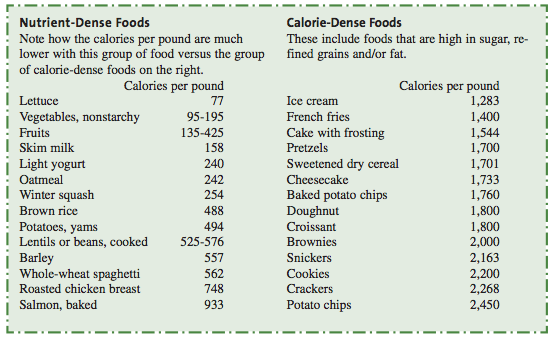Are You Getting Adequate Nutrients? A Lesson from the Dietary Guidelines for Americans
 The 2005 Dietary Guidelines for Americans call for adequate nutrients without consuming too many calories. For most people, this means you have to concentrate on eating more nutrient-dense foods and fewer calorie-dense foods. Our chart above illustrates the calorie difference between these two types of foods.How do I get adequate nutrients without too many calories?You need to get enough nutrients from high-quality foods but you need to also control the amount of calories that you eat. The key to this recommendation is to eat plenty of fruits, vegetables, whole grains and nonfat dairy foods while limiting intake of fats and added sugars.Eat a variety of nutrient-dense foods from these basic food groups: • Fruits • Vegetables and legumes • Whole cooked grains • Lean meat, poultry, seafood • Nonfat dairy productsYour best bet is to get back in your kitchen. Keep healthful foods on hand so you can prepare foods quickly and easily. Try new recipes and new foods. You will burn more calories by cooking versus sitting, too.What are examples of nutrient-dense foods?These include berries, apples, oranges, broccoli, sweet potatoes, lettuce, tomatoes, brown rice, oatmeal, whole-wheat pasta, black beans, pinto beans, chicken breast, salmon, skim milk and light nonfat yogurt.What are examples of calorie-dense foods?These include fried foods, most fast foods, ice cream, pastries, cereal bars, muffins, quick breads, biscuits, candy, cookies, cake, chips, regular soda, oil, cheese, bread, bagels, crackers, pretzels and milk shakes.
The 2005 Dietary Guidelines for Americans call for adequate nutrients without consuming too many calories. For most people, this means you have to concentrate on eating more nutrient-dense foods and fewer calorie-dense foods. Our chart above illustrates the calorie difference between these two types of foods.How do I get adequate nutrients without too many calories?You need to get enough nutrients from high-quality foods but you need to also control the amount of calories that you eat. The key to this recommendation is to eat plenty of fruits, vegetables, whole grains and nonfat dairy foods while limiting intake of fats and added sugars.Eat a variety of nutrient-dense foods from these basic food groups: • Fruits • Vegetables and legumes • Whole cooked grains • Lean meat, poultry, seafood • Nonfat dairy productsYour best bet is to get back in your kitchen. Keep healthful foods on hand so you can prepare foods quickly and easily. Try new recipes and new foods. You will burn more calories by cooking versus sitting, too.What are examples of nutrient-dense foods?These include berries, apples, oranges, broccoli, sweet potatoes, lettuce, tomatoes, brown rice, oatmeal, whole-wheat pasta, black beans, pinto beans, chicken breast, salmon, skim milk and light nonfat yogurt.What are examples of calorie-dense foods?These include fried foods, most fast foods, ice cream, pastries, cereal bars, muffins, quick breads, biscuits, candy, cookies, cake, chips, regular soda, oil, cheese, bread, bagels, crackers, pretzels and milk shakes.


